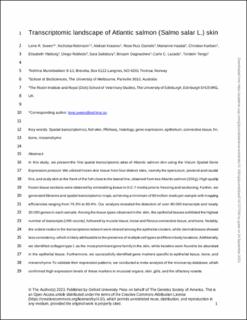Transcriptomic landscape of Atlantic salmon (Salmo salar L.) skin
| dc.contributor.author | Sveen, Lene | |
| dc.contributor.author | Robinson, Nicholas Andrew | |
| dc.contributor.author | Krasnov, Aleksei | |
| dc.contributor.author | Daniels, Rose Ruiz | |
| dc.contributor.author | Vaadal, Marianne | |
| dc.contributor.author | Karlsen, Christian | |
| dc.contributor.author | Ytteborg, Elisabeth | |
| dc.contributor.author | Robledo, Diego | |
| dc.contributor.author | Salisbury, Sarah | |
| dc.contributor.author | Dagnachew, Binyam Sime | |
| dc.contributor.author | Lazado, Carlo C. | |
| dc.contributor.author | Tengs, Torstein | |
| dc.date.accessioned | 2023-09-25T09:08:22Z | |
| dc.date.available | 2023-09-25T09:08:22Z | |
| dc.date.created | 2023-09-21T23:01:48Z | |
| dc.date.issued | 2023 | |
| dc.identifier.citation | G3: Genes, Genomes, Genetics. 2023, 1-34. | |
| dc.identifier.issn | 2160-1836 | |
| dc.identifier.uri | https://hdl.handle.net/11250/3091691 | |
| dc.description.abstract | In this study, we present the first spatial transcriptomic atlas of Atlantic salmon skin using the Visium Spatial Gene Expression protocol. We utilized frozen skin tissue from four distinct sites, namely the operculum, pectoral and caudal fins, and scaly skin at the flank of the fish close to the lateral line, obtained from two Atlantic salmon (150 g). High quality frozen tissue sections were obtained by embedding tissue in O.C.T media prior to freezing and sectioning. Further, we generated libraries and spatial transcriptomic maps, achieving a minimum of 80 million reads per sample with mapping efficiencies ranging from 79.3% to 89.4%. Our analysis revealed the detection of over 80.000 transcripts and nearly 30.000 genes in each sample. Among the tissue types observed in the skin, the epithelial tissues exhibited the highest number of transcripts (UMI-counts), followed by muscle tissue, loose and fibrous connective tissue, and bone. Notably, the widest nodes in the transcriptome network were shared among the epithelial clusters, while dermal tissues showed less consistency, which is likely attributable to the presence of multiple cell types at different body locations. Additionally, we identified collagen type 1 as the most prominent gene family in the skin, while keratins were found to be abundant in the epithelial tissue. Furthermore, we successfully identified gene markers specific to epithelial tissue, bone, and mesenchyme. To validate their expression patterns, we conducted a meta-analysis of the microarray database, which confirmed high expression levels of these markers in mucosal organs, skin, gills, and the olfactory rosette. | |
| dc.language.iso | eng | |
| dc.title | Transcriptomic landscape of Atlantic salmon (Salmo salar L.) skin | |
| dc.title.alternative | Transcriptomic landscape of Atlantic salmon (Salmo salar L.) skin | |
| dc.type | Peer reviewed | |
| dc.type | Journal article | |
| dc.description.version | publishedVersion | |
| dc.source.pagenumber | 1-34 | |
| dc.source.journal | G3: Genes, Genomes, Genetics | |
| dc.identifier.doi | 10.1093/g3journal/jkad215 | |
| dc.identifier.cristin | 2177730 | |
| dc.relation.project | Fiskeri- og havbruksnæringens forskningsfinansiering: 901631 | |
| dc.relation.project | Nofima AS: 13281 | |
| dc.relation.project | Norges forskningsråd: 300825 | |
| dc.relation.project | Nofima AS: 13152 | |
| dc.relation.project | Nofima AS: 13013 | |
| cristin.ispublished | true | |
| cristin.fulltext | original | |
| cristin.qualitycode | 2 |
Files in this item
This item appears in the following Collection(s)
-
Artikler / Articles [1456]
-
Publikasjoner fra CRIStin [2533]
